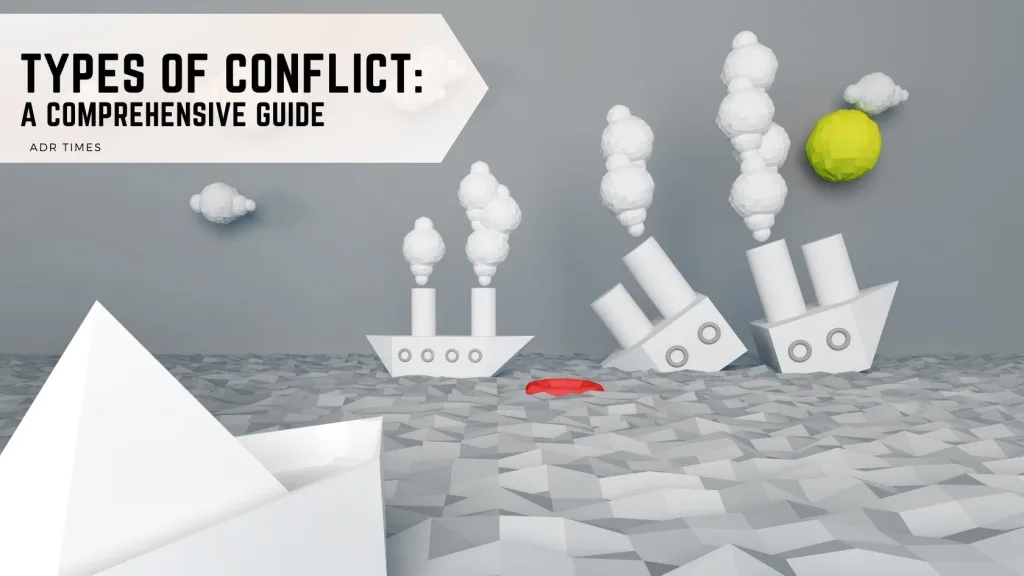Conflict is an inevitable part of life, and there are many types of conflict that we experience throughout our daily lives. They can manifest in our relationships, professional interactions, or even within ourselves as we grapple with internal dilemmas and desires.
While internal conflict can often feel uncomfortable or distressing, it also presents opportunities for growth, change, and a deeper understanding of ourselves and others.
The Different Types of Conflict: Four Basic Types
Understanding the different types of conflict can empower us to handle these challenging situations more effectively. By recognizing the nature of our conflicts, we can choose the most suitable strategies to resolve them, fostering healthier relationships and personal growth.
In this blog post, we will delve into the various types of conflict and provide insights on managing them.
Understanding the Interpersonal Conflict
Interpersonal conflict is a common external conflict between two or more individuals. It often arises from disagreements over ideas, decisions, or actions.
It can also spawn from personality clashes where differing temperaments and behaviors lead to tension. This external conflict is prevalent in personal relationships, such as friendships and family ties, and professional environments, like offices or collaborative projects.
Interpersonal conflict can be categorized into substantive external conflicts (based on disagreements over tasks or content) and emotional external conflicts (based on feelings, personal issues, or individual style). Both types can be constructive, leading to better understanding and growth, or destructive, causing stress, hostility, and broken relationships.
How To Resolve Them
Open communication is the cornerstone of resolving interpersonal conflicts. It’s important to voice your feelings and perspectives clearly and respectfully, ensuring your words reflect your intentions accurately. Active listening is equally crucial – strive to understand the other party’s viewpoint without interrupting or prematurely judging.
Conflict resolution strategies can be beneficial, such as compromise (finding a middle ground), collaboration (finding a win-win solution), or sometimes even third-party mediation. Remember, the goal is not to ‘win’ the argument but to reach a mutual understanding or agreement that respects everyone’s needs and concerns.
Understanding the Intrapersonal Conflict
In contrast to interpersonal conflict, intrapersonal conflict happens within an individual and is categorized as a personal struggle. It’s an internal conflict of the mind and heart, often manifesting as inner turmoil, self-doubt, emotional pain, or ethical dilemmas. This type of self-conflict can be based on many factors, including conflicting values and desires or discrepancies between one’s self-perception and reality.
Intrapersonal conflict can be categorized into three types: approach-approach conflict (choosing between two equally appealing options), avoidance-avoidance conflict (choosing between two equally unappealing options), and approach-avoidance conflict (being attracted to and repelled by the same option).
How To Resolve Them
Resolving intrapersonal conflict often requires introspection and self-awareness of our lives. You might need to evaluate your values, beliefs, goals, or self-perception to find a resolution. Mindfulness practices such as meditation, journaling, or yoga can help you stay connected to your inner self and better understand your feelings and thoughts.
Seeking advice from trusted friends, family members, or therapists can also be beneficial. They can provide an outside perspective, emotional support, or professional guidance to help you navigate your internal struggle.
Intergroup Conflict Type & How To Prevent It
Intergroup conflict arises when disagreements, rivalries, or tensions between different groups or two or more groups. This type of external conflict can occur in various contexts, from departments within a company vying for resources to ethnic groups clashing over cultural differences or political factions disagreeing on policy issues.
Competition, perceived inequities, or misunderstandings can drive intergroup conflicts. They can lead to hostility and division, but if managed well, they can also stimulate creativity, innovation, and beneficial change.
How To Resolve Them
Addressing intergroup conflict often requires fostering understanding and empathy between the groups. Facilitated dialogue is one effective strategy, allowing each group to express its perspectives and hear the others’. This can break down stereotypes, clarify misunderstandings, and highlight shared interests that can serve as a foundation for cooperation.
Team-building activities can also resolve intergroup conflict by helping to promote personal connections and mutual respect among individuals from different groups. Mediation or negotiation by a neutral third party can be beneficial when conflict escalates, or the groups struggle to communicate effectively.
Intragroup Conflict Type & How To Prevent It
In contrast, intragroup conflict occurs within a single group. This could be due to power struggles, differing opinions, competition among group members, or discrepancies in values or goals. While intragroup conflict can cause stress and disrupt group cohesion, it can stimulate critical thinking, foster diverse ideas, and promote group performance constructively.
Dealing with intragroup conflict requires promoting a culture of respect and collaboration within the group. Establishing norms that encourage open discussions, constructive feedback, and considerate listening is crucial.
Conflict resolution strategies like consensus decision-making can be helpful. This involves discussing the issue as a group until everyone agrees on a solution. If consensus can’t be reached, a majority rule or decision by a leader or subcommittee may be necessary, provided that the process is seen as fair by all group members.
Understanding the Conflict with Nature Role Conflict
Conflict with nature represents a unique conflict that doesn’t involve human interactions but pertains to our challenges with the natural world. This can encompass a wide range of situations, from natural disasters like hurricanes or earthquakes to health crises like pandemics and environmental issues like climate change or deforestation.
The impact of these conflicts can be devastating, leading to loss of life, economic damage, and psychological distress. They also pose significant challenges for societies and individuals, as they often require large-scale, coordinated responses and can profoundly disrupt everyday life.
How To Resolve It
Preparation is crucial in managing nature conflicts. This includes developing emergency plans for natural disasters, investing in healthcare infrastructure to handle health crises, and implementing policies to mitigate environmental issues. Scientific research plays a key role in this preparation, as it can provide us with the knowledge needed to predict, understand, and respond to these challenges effectively.
Adaptability is another key factor in managing these conflicts. Nature is unpredictable and constantly changing, so our strategies must be flexible enough to accommodate these changes. This could mean adjusting our living habits to cope with climate change or adapting our healthcare strategies in response to new information about a disease.
Respect for the environment is essential in preventing further conflicts with nature. This means adopting sustainable practices, conserving natural resources, and reducing pollution. By caring for the environment, we can reduce the severity and frequency of these conflicts, ensuring a healthier planet for future generations.
Societal Conflict Type: The Internal and External Conflict
Societal conflict arises when disagreements or tensions arise among societal structures or cultural norms. These conflicts may stem from differing ideologies, economic disparities, or social inequalities.
How To Resolve Them
Resolving a societal conflict often requires systemic changes and collective action. This can involve advocacy, policy changes, or community-based initiatives. Education and awareness-raising are also critical in addressing societal conflicts, as understanding the root of these issues is the first step toward resolving them.
Another Major Conflict: Supernatural Conflict
Supernatural conflicts are often found in literature and film, where characters face challenges against supernatural forces beyond the natural world. This could be battling mythical creatures, dealing with magical forces, or confronting the divine.
A classic example of a main character battling a conflict of the supernatural is Mary Shelley’s Frankenstein. One character, Dr. Frankenstein, must battle a monster of his creation as he struggles to understand this character’s motivations.
Multiple conflicts erupt from this singular point, from human fears of the other to a battle between the main character’s personality and inner demons. When authors create a conflict of a supernatural nature, it serves more purpose than to move the plot forward.
How To Resolve Them
In stories, supernatural conflict often serves as a metaphor for internal or external struggles. The resolution of such conflicts can vary widely depending on the narrative but often involves the protagonist overcoming fear, accepting fate and gaining new understanding, or achieving personal growth.
Supernatural conflict in literature helps readers get into the mind of a main character and learn important lessons that can be applied to real life. While compelling characters and good stories often include fantastic elements that will never occur in the natural world, stories help us understand conflict and resolution in new ways that can be helpful.
Final Thoughts
Conflict, in its many forms, can be challenging to navigate. However, by understanding the different types of conflict and learning practical strategies to manage them, we can transform these challenges into opportunities for growth and development.
Remember, conflict isn’t inherently bad. Handling well can lead to constructive changes, improved relationships, and personal growth. So, next time you find yourself in a conflict, take a step back, identify the type of conflict, and approach it with the right strategy.
If you want to learn more about other types of conflict, conflict resolution, or alternative dispute resolution, contact ADR Times for training courses and educational content.
Must-read Articles:
- Understanding the Stages of Conflict: A Guide - July 23, 2024
- What Is Dehumanization? An In-Depth Overview - July 12, 2024
- Can Text Messages be Used in Court? A Close Look - July 11, 2024



